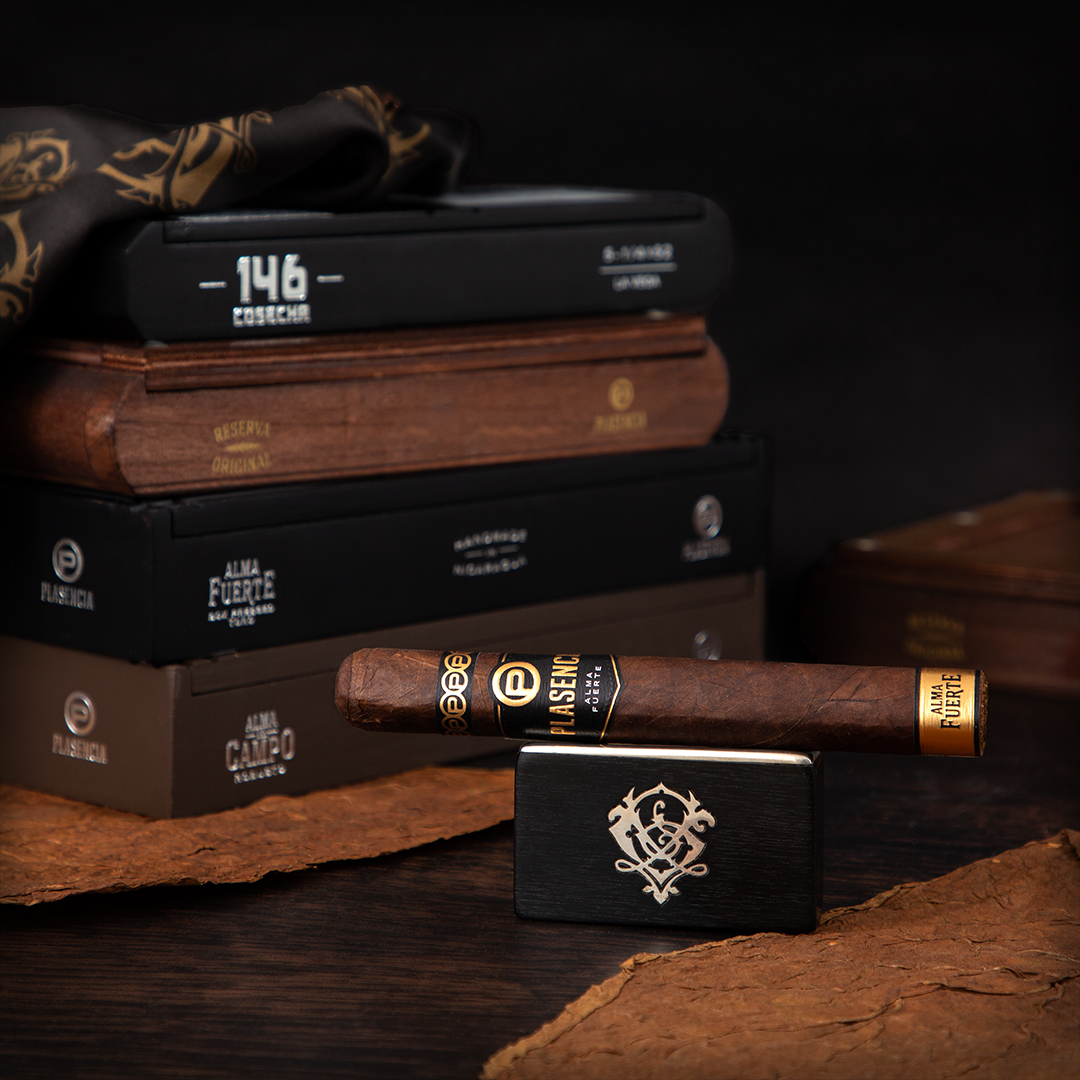Plasencia
Plasencia, over 150 years of family heritage in the field of tobacco.
Like so many other cigar stories, Plasencia's begins in Cuba in the 19th century. This five-generation family business is now one of the most respected in the tobacco industry. Its history is one of luck and misfortune, joy and grief, incredible success and fatal sorrow.
It all began in 1865, when a certain Eduardo Plasencia crossed the Atlantic Ocean from the Canary Islands in pursuit of opportunity and success. He will start to cultivate tobacco in the very famous region of Vuelta Abajo, in Cuba and will be joined by his nephew Sixto Plasencia Juares Senior in 1890, who will open the first family farm "El Corojal" 8 years later.
The latter will also be joined by his son of the same name, Sixto Plasencia Junior. Together, they quickly acquired the reputation of being very good growers and developed their activities by opening the company "Hijos de Sixto Plasencia", which sold and exported tobacco to larger companies.
Unfortunately, in 1959, a first cataclysm will hit the family during the Cuban Revolution. Fidel Castro's regime proceeded to seize all tobacco farms and the Plasencia family was forced to leave its Cuban life behind.
In 1963, Sixto Junior and his family moved to new lands, with only a few dollars in their pockets, to Mexico for two weeks and then to Nicaragua. After graduating from the agricultural university, Nestor, Sixto's son, began working in the same farm as his father, called "El Coyol". He made a successful living there until the Sandinista revolution of 1979 arrived. When the situation began to deteriorate in Nicaragua and the farm burned down, the family was once again forced to start from scratch, moving to Honduras. "Perseverance is in our blood" says Nestor, son of Sixto Junior. and grandson of Sixto Plasencia Juarez, with confidence, "I'm really proud of what my grandfather and my father accomplished. It's amazing how they survived it all".
The early 1980s were particularly challenging for Nestor, who bought a farm to plant 140 acres of Connecticut seed and built several drying barns with his own hands. His work paid off, the crop was glowing with bright green tobacco leaves. Unfortunately, the joy was short-lived.
One February morning in 1980, Nestor was awakened by one of his workers who said that the leaves on the crop were diseased. Having never seen anything like this before, he took a few leaves to his father Sixto who stated, without hesitation, that the blue mold had taken over the plantations. Tragically, the next morning, the crop was partially devastated.
The culture of the Plasencia will then be destroyed by the blue mold, up to 90%. To fight against this plague, they will use a new fungicide which, after excessive use, will make it even more resistant.
To keep his head above water, Nestor will have to sell some of his land, get loans and continue to work hard. He will therefore be led to think about new sources of income, notably by starting to produce cigars, with the help of his father, from 1985.
Following these numerous political and biological disasters, the Plasencia family returned to Nicaragua, the cradle of the brand, to give a new breath to the lands they had to leave behind years before.
By acquiring several farms in Estelí and Jalapa, they obtained enough tobacco for the production of their own cigars but also to sell it to other manufacturers. In just a few years, the Plasencia will completely recover and make all their debts disappear!
Joined by Nestor's sons, Nestor Andrés, who is now the head of the company, Gustavo, the middle brother, and José Luis, the youngest, five generations committed to offer superior quality cigars and continue to develop the over 150 years of heritage of the company.
In addition, the family pays great attention to the well-being of their employees and their personal development: the company offers seminars on reaching one's maximum potential, appointments with a psychologist, but also English courses. They encourage their teams to never give up and to achieve their goals at any cost.
Today, Plasencia is one of the main producers of premium tobacco in the world with more than 35 million handmade cigars per year and more than 1'200 hectares cultivated in several Central American countries including Nicaragua, Honduras, Costa Rica and Panama. Synonymous with traditional culture, harmoniously compiled tobacco creations and sophisticated smoking pleasure, Plasencia cigars enjoy an excellent reputation in the tobacco world.
All the cigars in Plasencia's catalog are handmade with high quality tobacco leaves grown in a traditional way, without any pesticides. All the plantations of the family are certified organic. Once harvested, the leaves are stored and fermented with the utmost care. The result is a natural tasting cigar, like the Reserva Original, which is entirely organic.
Regarding the Plasencia Cosecha 149 line, it is a tribute to Honduras, which the Plasencia family wanted to thanks for opening its doors after the Nicaraguan revolution in 1979. These cigars are made from the Plasencia's 149th annual tobacco harvest that took place in 2014.
The Plasencia Cosecha 146 is made from an exclusive blend of tobacco leaves harvested in 2011 and 2012. This crop is the 146th of the family since 1865. It is cultivated in the best regions of Honduras and Nicaragua.
The "Alma" series is divided into 3 parts: the Alma Fuerte, which translates as "Strength of Soul", is a premium line comprising some of the best tobaccos from Estelí, Condega, Jalapa and Ometepe, which have been aged for a minimum of 9 years.
The second part of the series, the Alma del Campo, or "Soul of the Field", is a cigar made from Nicaraguan Criollo 98 tobacco, delivering coffee, nuts and a little white pepper aromas accompanied by a nice creamy touch.
Finally, the Alma del Fuego, "Soul of Fire", highlights the strong character of the volcanic soil that comes from the island of Ometepe. It offers a spicy note, accompanied by tangerine, roasted cashew nuts and guava wood aromas.
In addition, the brand also stands out for its special productions such as the Plasencia Ehtëfal, translated as "celebration" whose blend of Honduran and Nicaraguan tobaccos have been aged for 10 years. It was launched at the same time and place as the 2022 Football World Cup in Qatar.
The company also strengthens its position as a cigar brand offering limited edition vitolas for the Chinese zodiac calendar. This year, it is the sign of the rabbit that is highlighted with the production of the Plasencia Year of the Rabbit, limited to 6'000 boxes of 10 units, which we will also present in this edition of the Grauer Journal.
With many titles to his credit, such as Life Time Achievement by Cigar Journal, or his place in the famous Hall of Fame of Cigar Aficionado, there is nothing that Nestor Plasencia does not master. He grows his own tobacco, rolls his own cigars, and has even contributed to other cigar brands, including Rocky Patel, Alec Bradley, and Casa Magna to name a few. Because of this strong involvement in all aspects of cigar creation, enjoying a Plasencia cigar is guaranteed to be an exciting and unique experience.
To learn more about Plasencia cigars and the history of the brand, we would be delighted to welcome you in our Walk-In humidor, where you will find our selection of the brand's cigars, in special productions, but also in regular production.
Login to your online account to reserve your item
or contact us at +41 22 552 2799


